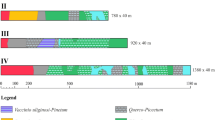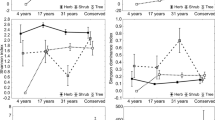Abstract
A hierarchical approach for plant functional classification was applied to describe long-term vegetation change in Pinus halepensis burned forests. Plant species were initially grouped according to their growth form and afterwards data on species modes of regeneration, persistence and dispersal, together with some other specific competitive advantages were explored, resulting in the identification of 29 different functional groups, 14 for woody and 15 for herbaceous species. Three types of Pinus halepensis forests were identified, according to the structure of the understorey. For each forest type, a post-fire chronosequence of communities was selected for sampling. Data sampling was performed for at least two consecutive years in each community, so as to reduce the shortcomings of the synchronic approach and to increase the age range of each chronosequence. Even though the vast majority of the functional groups proved to be persistent throughout the post-fire development of vegetation, their species richness and abundance did not remain stable. An increase of annual herb richness and abundance was recorded in the first years after the fire, with the leguminous species forming the dominant functional group. For perennial herbs, the most abundant group was of species with vivid lateral growth, while the group of species with subterranean resource organs included the highest number of species. Finally, as far as the woody species are concerned, the groups that played the most important role in defining vegetation structure were the mono-specific group of the pine, the group of resprouting sclerophyllous tall shrubs and the group of obligate seeder short shrubs (with Cistusspp., among others). A negative relationship between the abundance of woody obligate resprouters and the regeneration of woody obligate seeders was found. The advantage of the proposed functional group approach over classical floristic or structural approaches for the long-term study of communities is discussed, together with the applicability of this approach in studies of vegetation risk assessments due to fire regime alterations.
Similar content being viewed by others
References
Agee J.K. 1998. Fire and pine ecosystems. In: Richardson D.M. (ed.), Ecology and Biogeography of Pinus. Cambridge University Press, New York, pp. 193-218.
Arianoutsou M. 2001. Landscape changes in Mediterranean ecosystems of Greece: implication for fire and biodiversity. Journal of Mediterranean Ecology 2: 165-178.
Arianoutsou M. 2002. Ecological indicators of post-fire resilience in Pinus halepensis forests. In: Thanos C.A. (ed.), Book of Abstracts of the International Conference on Mediterranean Pines (MEDPINE 2). Chania, Greece, p. 6.
Arianoutsou M. and Ne'eman G. 2000. Post-fire regeneration of natural Pinus halepensis forests in the East Mediterranean Basin. In: Ne'eman G. and Trabaud L. (eds), Ecology Biogeography and Management of Pinus halepensis and Pinus brutia Forest Ecosystems in the Mediterranean Basin. Backhuys Publishers, Leiden, The Netherlands, pp. 269-289.
Arianoutsou M. and Thanos C.A. 1996. Legumes in the fire-prone Mediterranean environment. International Journal of Wildland Fire 6: 77-82.
Arianoutsou M., Kazanis D., Kokkoris Y. and Skourou P. 2002. Land-use interactions with fire in Mediterranean Pinus halepensis landscapes of Greece: patterns of biodiversity. In: Viegas D.X. (ed.), Proceedings of the 4th International Conference of Forest Fire Research. Luso, Portugal. Millpress, The Netherlands, electronic edition.
Attiwill P.M. 1994. The disturbance of forest ecosystems: the ecological base for conservative management. Forest Ecology and Management 63: 247-300.
Brower J.E., Zar J.H. and von Ende, C.N. 1990. Field and laboratory methods for general ecology. W.C. Brown Publishers, Dubuque.
Burrows C.J. 1990. Processes of vegetation change. Unwin Hyman Eds., London.
Campbell, B.D., Stafford Smith, D.M. and Ash, A.J. 1999. A rulebased model for the functional analysis of vegetation change in Australasian grasslands. Journal of Vegetation Science 10: 723-730.
Caturla R.N., Raventos J., Guardia R. and Vallejo, VR. 2000. Early post-fire regeneration dynamics of Brachypodium retusum Pers. (Beauv.) in old fields of the Valencia region (eastern Spain). Acta Oecologica 21: 1-12.
Davis G.W. 1998. Landscapes and biodiversity in Mediterraneantype ecosystems: the role of changing fire regimes. In: Moreno J.M. (ed.), Large forest fires. Buckhuys Publishers, Leiden, pp. 109-131.
Diaz S. and Cabido M. 2001. Vive la difference: plant functional diversity matters to ecosystem processes. Trends in Ecology and Evolution 16: 646-655.
Franklin J., Syphard A.D., Mladenoff D.J., He H.S., Simons D.K., Martin R.P., Deutschman D. and O'Leary J.F. 2001. Simulating the effects of different fire regimes on plant functional groups in Southern California. Ecological Modelling 142: 261-283.
Grove A.T. and Rackham O. 2001. The Nature of Mediterranean Europe: An Ecological History. Yale University Press, New Haven and London.
Greuter W., Burdet H.M. and Long G. (1984-1989). Med-Checklist, Volumes 1, 3, 4. Geneve.
Hanes T.L. 1971. Succession after fire in the chaparral of southern California. Ecological Monographs 41: 27-52.
Herranz J.M., Martinez-Sanchez J.J., Marin A. and Ferrandis P. 1997. Postfire regeneration of Pinus halepensis in a semi-arid area in Albacete province (southeastern Spain). Ecoscience 4: 86-90.
Huston M.A. 1994. Biological Diversity. Cambridge University Press.
Kazanis D. and Arianoutsou M. 1996. Vegetation composition in a post-fire successional gradient of Pinus halepensis forests in Attica Greece. International Journal of Wildland Fire 6: 83-91.
Kazanis D. and Arianoutsou M. 2002. Long term post-fire dynamics of Pinus halepensis forests of Central Greece: plant community patterns. In: Viegas D.X. (ed), Proceedings of the 4th International Conference of Forest Fire Research. Luso, Portugal, Millpress, The Netherlands, electronic edition.
Kazanis D. and Arianoutsou M. 2003. Post-fire regeneration of mediterranean pine forests: studying the effect of fire severity on the temporal regeneration pattern of annual herbaceous plants. In: Book of Abstracts of the 25th Conference of the Hellenic Society for Biological Sciences, Lesvos, Greece, p. 113.
Keeley J.E. 1986. Resilience of mediterranean shrub communities to fire. In: Dell B., Hopkins A.J.M. and Lamont B.B. (eds), Resilience in Mediterranean-type Ecosystems. Dr.W. Junk Publishers, Dordrecht, The Netherlands, pp. 95-112.
Keeley J.E. and Keeley S. C. 1981. Postfire regeneration of Californian chaparral. American Journal of Botany 68: 524-530.
Kutiel P. 2000. Plant composition and plant species diversity in East Mediterranean Pinus halepensis Mill. forests. In: Ne'eman G. and Trabaud L. (eds), Ecology Biogeography and Management of Pinus halepensis and Pinus brutia Forest Ecosystems in the Mediterranean Basin. Backhuys Publishers, Leiden, The Netherlands, pp. 143-152.
Kutiel P. and Kutiel H. 1989. Effects of a wildfire on soil nutrients and vegetation in an Aleppo pine forest, on Mt Carmel, Israel. Pirineos 134: 59-74.
Lavorel S., Canadell J., Rambal S. and Terradas J. 1998. Mediterranean terrestrial ecosystems: research priorities to global change effects. Global Ecology and Biogeography Letters 7: 157-166.
Mirov N.T. 1967. The genus Pinus. Ronald Press, New York.
Naveh Z. 1994. The role of fire and its management in the conservation of mediterranean ecosystems and landscapes. In: Moreno J.M. and Oechel W.C. (eds), The role of fire in Mediterraneantype ecosystems. Springer-Verlag Publishing, London, pp.163-185.
Ne'eman G., Lahav H. and Izhaki I. 1992. Spatial pattern of seedlings one year after fire in Mediterranean pine forests. Oecologia 91: 365-370.
Papavassiliou S. and Arianoutsou M. 1993. Regeneration of the leguminous herbaceous vegetation following fire in a Pinus halepensis forest of Attica, Greece. In: Trabaud L. and Prodon R. (eds), Fire in Mediterranean Ecosystems. Ecosystems Research Report no 5, Commission of the European Communities, pp. 119-127.
Papavassiliou S. and Arianoutsou M. 1998. Flora, nodulation capacity and reproductive biology of Leguminosae in burned Pinus halepensis forests of Attica, Greece. In: Viegas D.X. (ed.), Proceedings of the 3rd International Conference of Forest Fire Research. Luso, Portugal, pp. 1587-1588.
Pausas J.G. 1998. Modeling fire-prone vegetation dynamics. In: Trabaud L. (ed.), Fire management and landscape ecology. IAWF, Washington, pp. 327-334.
Pausas J.G. 1999a. Mediterranean vegetation dynamics: modeling problems and functional types. Plant Ecology 140: 27-39.
Pausas J.G. 1999b. Response of plant functional types to changes in the fire regime in Mediterranean ecosystems: A simulation approach. Journal of Vegetation Science 10: 717-722.
Pausas J.G. and Lavorel S. 2003. A hierarchical deductive approach for functional types in disturbed ecosystems. Journal of Vegetation Science, Journal of Vegetation Science 14: 409-416.
Richardson D.M. and Rundel P.W. 1998. Ecology and biogeography of Pinus: an introduction. In: Richardson D.M. (ed.), Ecology and biogeography of Pinus. Cambridge University Press, New York, pp. 3-46.
Schiller G., Ne'eman G. and Korol L. 1997. Post-fire vegetation dynamics in a native Pinus halepensis forest on Mt. Carmel Israel. Israel Journal of Plant Sciences 45: 297-308.
Seligman N.G. and Henkin Z. 2000. Regeneration of a dominant Mediterranean dwarf-shrub after fire. Journal of Vegetation Science 11: 893-902.
Tester J.R. 1989. Effects of fire frequency on oak savanna in eastcentral Minnesota. Bulletin of the Torrey Botanical Club 116: 134-144.
Thanos C.A., Daskalakou E.N. and Nikolaidou S. 1996. Early post-fire regeneration of a Pinus halepensis forest on Mount Parnis, Greece. Journal of Vegetation Science 7: 273-280.
Trabaud L. 2000. Post-fire regeneration of Pinus halepensis forests in the West Mediterranean Basin. In: Ne'eman G. and Trabaud L. (eds), Ecology Biogeography and Management of Pinus halepensis and Pinus brutia Forest Ecosystems in the Mediterranean Basin. Backhuys Publishers, Leiden, The Netherlands, pp. 257-268.
Trabaud L. and Lepart J. 1980. Diversity and stability in garrigue ecosystems after fire. Vegetatio 43: 49-57.
Trabaud L., Grosman J. and Walter T. 1985a. Recovery of burned Pinus halepensis Mill. forests I. Understorey and litter phytomass development after wildfire. Forest Ecology and Management 12: 269-277.
Trabaud L., Michels C. and Grossman J. 1985b. Recovery of burned Pinus halepensis Mill. forests I. Pine reconstitution after wildfire. Forest Ecology and Management 13: 167-179.
Tutin T.G., Heywood V.H., Burges N.A., Valentine D.H., Walters S.M. and Moore D.M. 1968-1993. Flora Europaea, Volumes I-V. Cambridge University Press.
Walter H. 1968. Die Vegetation der Erde in Oekophysiologischer Betrachtung, Vol. 2. Fischer, Jena.
Author information
Authors and Affiliations
Corresponding author
Rights and permissions
About this article
Cite this article
Kazanis, D., Arianoutsou, M. Long-term post-fire vegetation dynamics in Pinus halepensis forests of Central Greece: A functional group approach. Plant Ecology 171, 101–121 (2004). https://doi.org/10.1023/B:VEGE.0000029376.15741.b4
Issue Date:
DOI: https://doi.org/10.1023/B:VEGE.0000029376.15741.b4




